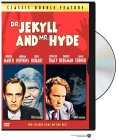Synopsis
The version of the story these films tell much the same, given that the 1941 Spencer Tracyeffort was a remake of the 1932 Fredric March production. Handsome Dr. Henry Jekyll,frustrated over being denied an earlier marriage to his fiancee (Rose Hobart in 1932, Lana Turnerin ‘41), quaffs a potion and becomes the monstrous Edward Hyde. Hyde’s principle victim is Ivy(Miriam Hopkins/Ingrid Bergman), the woman on whom Jekyll’s now unleashed sexuality ventsits fury.
…p>That the ‘41 version is a defanged, desexualized treatment of the earlier film’s material isvisible in the fact that Ingrid Bergman’s Ivy is now a barmaid, rather than Miriam Hopkins’incendiary prostitute. Longer, more ponderous, more solemn and sillier, Victor Fleming’s film isnot without interest, though some of that comes from the perverse casting: Lana Turner as thegood girl and Bergman as the bad one is like having Julia Roberts and Sharon Stone switch roles.(We won’t talk about Bergman’s surreal attempt at a cockney accent, but her performance is stillvery good..) The film is still worth watching, but part of its effect is to show what a masterpiecethe ‘32 version is. Astonishingly frank in its sexual themes (it was heavily cut once theProduction Code kicked in, and even now, though largely restored, some of the racier footageseems to be lost forever), and cinematically exhilarating, director Rupert Mamoulian’s visiongives us the most terrifying Hyde ever. March’s Hyde and Hopkins’ Ivy have one of cinema’smost nightmarish relationships, and March’s performance deservedly one an Oscar — the lasttime a horror movie would win the Best Actor or Actress statuette until Kathy Bates won forMisery.
Audio
The soundtracks are mono, and we are spared ill-advised attempts to make the films stereo.The quality of the sound depends on the version. The 1932 film (barely five years into the soundera, remember) has a fair bit of hiss, and the music (when there is any) tends to waver, but this isthe print, not the transfer. The 1941 film’s sound is, as you would expect, clearer andcleaner.
Video
The 1941 film looks great, with very little grain and sharp, clean black-and-white. The 1932film shows its age much more visibly. There are splices, a fair bit of speckling, and some shotsare quite badly damaged and grainy. By and large, the look isn’t bad for a 70+-year-old film, but Ido think a bit more effort could have been put into the restoration.
Special Features
Film historian Greg Mank’s commentary on the 1932 film is first-rate. Here’s everything youmight want to learn about the film’s battles with censorship, the behind-the-scenes antics ofMiriam Hopkins, the background of the actors, the making of the film — the works, in otherwords. Mank is an engaging speaker, and his enthusiasm for the film is infectious. The otherextras are a Jekyll & Hyde-themed Bugs Bunny cartoon and the trailer for the 1941 film. Themain page of the menu is scored.
Closing Thoughts
Both these films are worth owning, and having them on one DVD, with a commentary onMamoulian’s film to boot, makes this release an early highlight of 2004 for fans of classichorror.
Special Features List
- Audio Commentary for 1932 Feature
- Bugs Bunny Cartoon “Hyde and Hare”
- 1941 Theatrical Trailer





